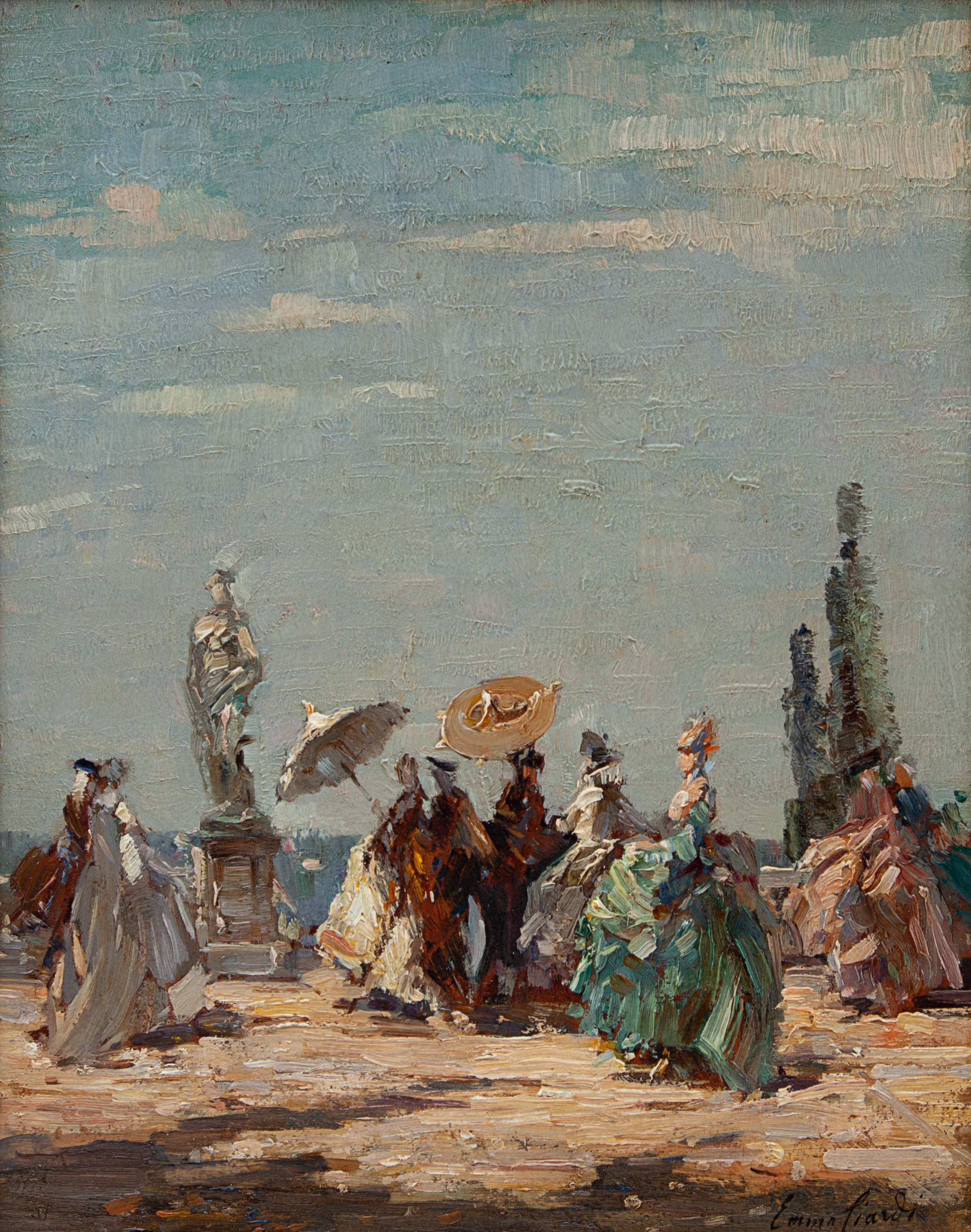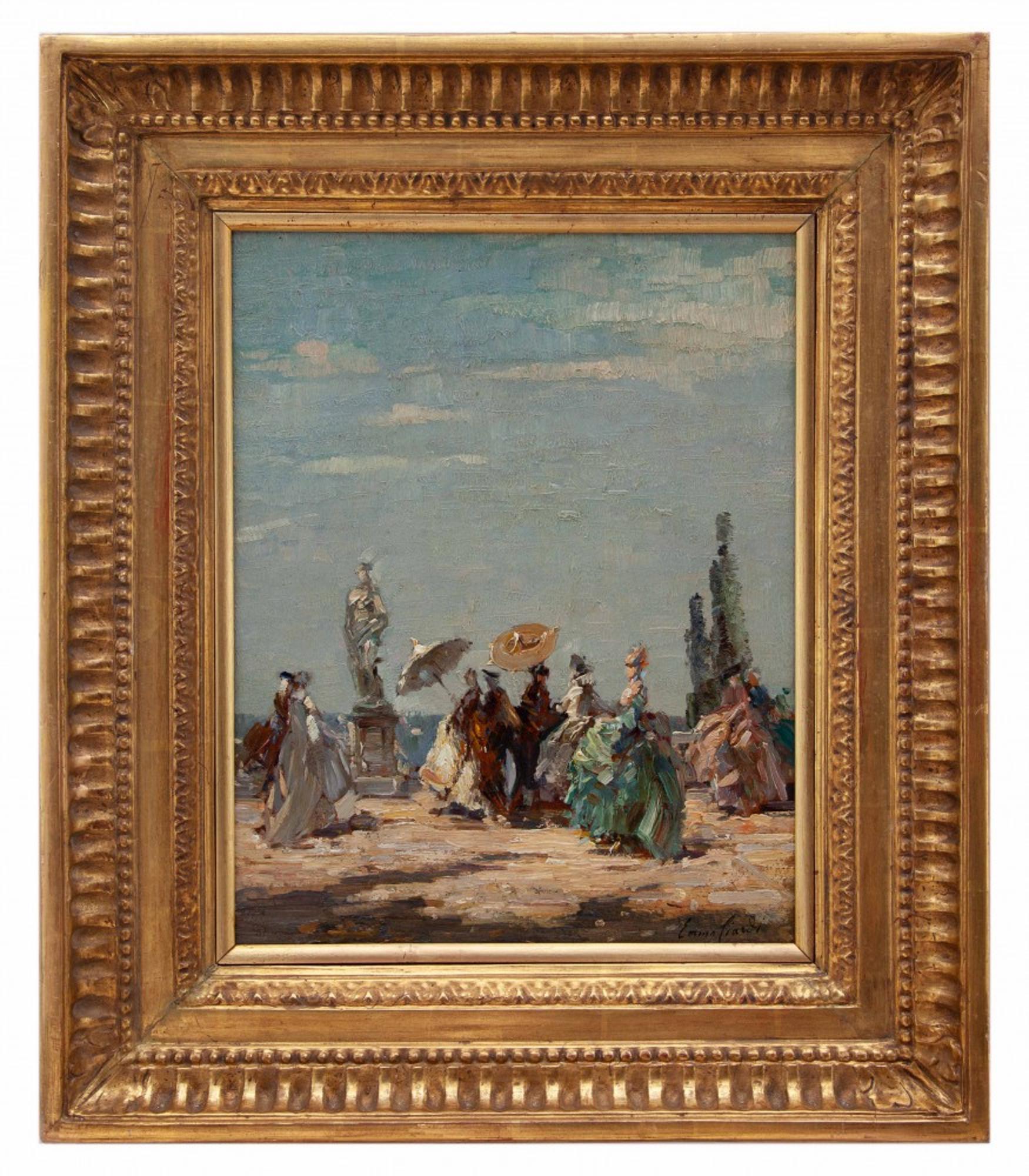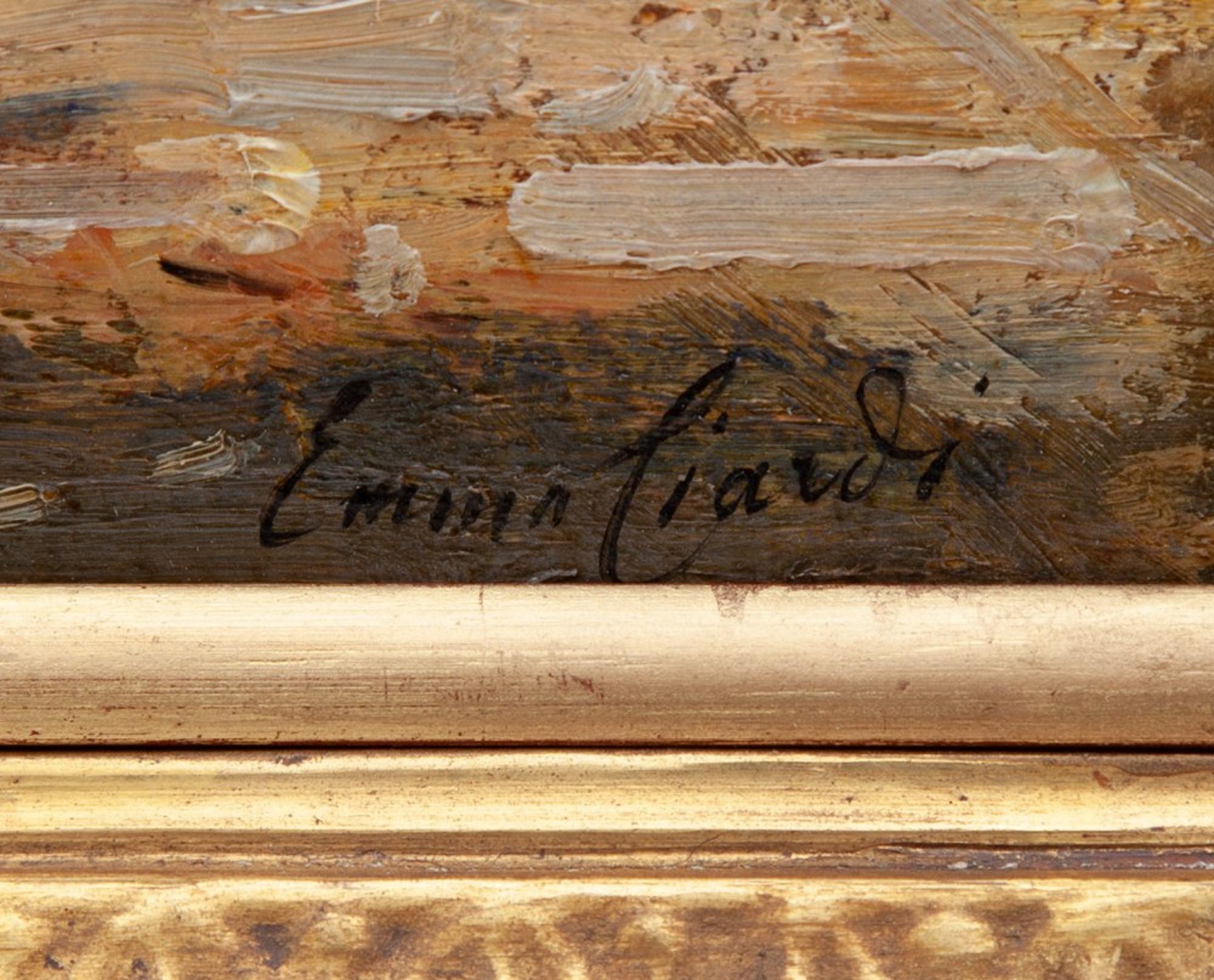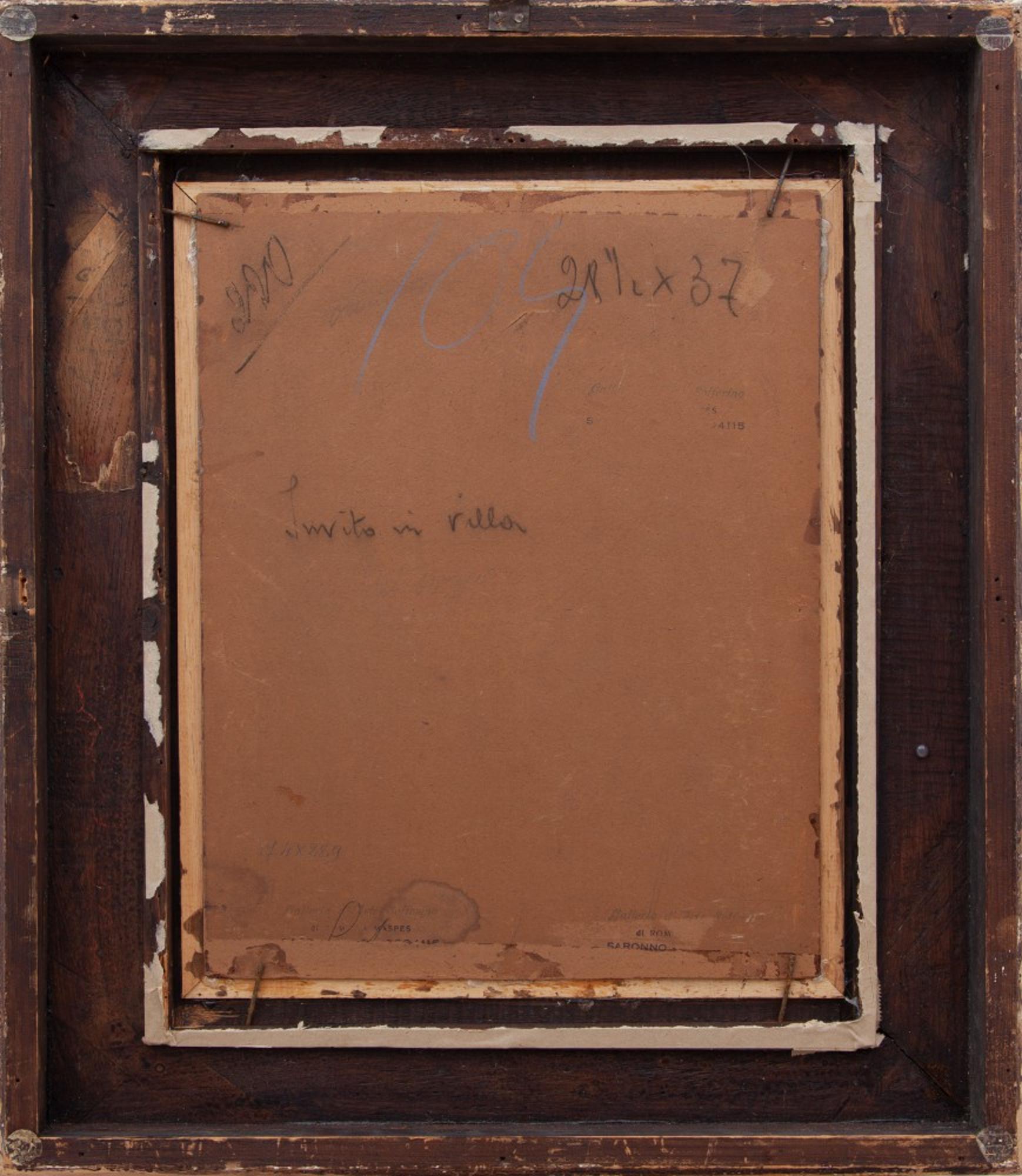8
"Invito in villa" - Emma Ciardi
(Venezia 1879 - Venezia 1933)
Cm 37x29 | In 14.57x11.42
Oil on cardboard
A daughter of art, she was initiated at an early age into painting by her father, Guglielmo Ciardi, a protagonist with Favretto of the Venetian School of the Real and from 1894 holder of the chair of "Town and Sea Views" at the Venice Academy of Fine Arts. Together with his father and brother Beppe Ciardi they painted from life, as Guglielmo had learned at the Academy when, a pupil of Domenico Bresolin, he was brought by the master into the presence of nature. Emma Ciardi is a woman for the time in which she finds herself living, at the turn of the 19th and 20th centuries, outside the box. She lives the transition between the nineteenth and twentieth centuries in the midst of epochal revolutions that will transform the world, chooses to fit into the tradition of vedutismo that has its masters in Carlevarijs and Canaletto, and does so with a personal and unmistakable style. A constant presence at the Biennial (from 1903 to 1932, except for the 1926 edition), he travels, knows English and French, takes his Venetian parlar around the world, participates in all the most important national (Turin, Milan, Florence, Rome, Naples) and International (Munich, Barcelona, Paris, Buenos Aires, Pittsburgh, San Francisco) art festivals, holds his solo exhibitions in London (1910, 1913, 1928), Paris (1914), New York (1924), Brussels (1925), Chicago (1924), the most accredited gallery owners offer her their spaces to show her works in Milan, London, Paris, New York, collectors from all over Europe and America buy her paintings, newspapers speak of her as "among the most interesting and most personal painters, painters and not women painters because Ciardi is such an artist that she needs no such distinction." Not many women can make a profession out of their talent, Emma does and with an entrepreneurial spirit unheard of for a woman of the early twentieth century she marries her work. A true star of the time. Even D'Annunzio passing through Venice goes to visit her in her atelier where, without getting lost in "ciacole," she works. Thinking that a painter should express himself with his brushes and colors and not with words, she repeats, "Co le ciacole non si fanno i quadri." A woman of few words and a lot of work (as Ugo Ojetti wrote about her in the Corriere della Sera in 1909), she obtained in the first three decades of the twentieth century public and critical recognition and awards in Milan, Berlin, London, Paris, Brussels, New York, and San Francisco. An extremely fecund painter, her paintings are scattered all over the world, she works for an international clientele that from Venice to London and from New York to Buenos Aires requests her paintings. While Picasso initiated with Cubism a veritable revolution in the field of art by subverting the traditional way of viewing a painting and creating an obvious shock in the public, Futurism launched incendiary proclamations subverting tradition, Emma Ciardi entered the great vein of Venetian vedutista painting. She studies and loves Guardi and, like Cataletto does with the camera ottica, photographs the motifs that strike her or paints en plein air, like the Impressionists in parks and gardens of aristocratic mansions and then processes the impression in the studio. She writes, "I have made two studies, but the painting I have not yet found. These are tints that I will need to compose the paintings that always have to be invented," an obvious statement of poetics and operative practice. He chooses to portray the landscape, makes portraits of cities with which he becomes acquainted Florence, London, Paris, Basel, Bruges. Venice and ancient gardens populated by ancient ladies and knights are the great protagonists of her repertoire. In the gardens that make her famous, she starts from life, observes and fixes the landscape before her eyes then, in the studio, brings into the compositions a crowd of characters dressed in eighteenth-century fashions arranging them on the scene studied from life. They are not characters, actors (her models are wooden mannequins two span high that Emma herself drapes in eighteenth-century robes and tricorns), but pure semblances of light, conjured up to act out the fable of life. For Emma, the real is the base, the springboard to the dream. Her figures, luminous as if they were emanations of places, stand out chromatically on the meadows like gems set in green. Her light and bright painting is dense with matter; one has to look closely at her paintings to appreciate the rich, color-filled thickness of her painterly touch. He often uses white; every inch of painting is a chromatic feast, a feast for the eyes. In the last period of his existence he found new inspiration in Refrontolo, in the Treviso countryside, where he bought a house and retired to the quiet of the countryside to paint. Here, dormant whispers and rustles, idylls, dances and madrigals, vezzi and graces (words that often return in the titles of her works) it is nature that speaks in her paintings with grandiose simplicity. If at the time Emma's painting appealed without disturbing, even today her skillful craft, her minute, fractured brushwork, teeming with hues, fast, that she is able to evoke with the slightest touch of the brush a gondola, a parasol, a Pierrot's guitar, with a touch that is always sure, without retouching "i quadri va in malora se i xe titignai," sparkling knows how to fascinate and seduce. In the tamed landscapes, in the combed skies, in the radiant and poignant Venices, together with Emma we seek the beauty for which the human being of all times yearns. She died in Venice on November 16, 1933. In the Information Sheet handwritten by Emma in 1932, kept at the Historical Archives of Contemporary Arts in Venice, she states that her works have been acquired and are held in public collections in Vienna, New York, Munich, Barcelona, Brussels, Washington, Oran and Buenos Aires.
(Venezia 1879 - Venezia 1933)
Cm 37x29 | In 14.57x11.42
Oil on cardboard
A daughter of art, she was initiated at an early age into painting by her father, Guglielmo Ciardi, a protagonist with Favretto of the Venetian School of the Real and from 1894 holder of the chair of "Town and Sea Views" at the Venice Academy of Fine Arts. Together with his father and brother Beppe Ciardi they painted from life, as Guglielmo had learned at the Academy when, a pupil of Domenico Bresolin, he was brought by the master into the presence of nature. Emma Ciardi is a woman for the time in which she finds herself living, at the turn of the 19th and 20th centuries, outside the box. She lives the transition between the nineteenth and twentieth centuries in the midst of epochal revolutions that will transform the world, chooses to fit into the tradition of vedutismo that has its masters in Carlevarijs and Canaletto, and does so with a personal and unmistakable style. A constant presence at the Biennial (from 1903 to 1932, except for the 1926 edition), he travels, knows English and French, takes his Venetian parlar around the world, participates in all the most important national (Turin, Milan, Florence, Rome, Naples) and International (Munich, Barcelona, Paris, Buenos Aires, Pittsburgh, San Francisco) art festivals, holds his solo exhibitions in London (1910, 1913, 1928), Paris (1914), New York (1924), Brussels (1925), Chicago (1924), the most accredited gallery owners offer her their spaces to show her works in Milan, London, Paris, New York, collectors from all over Europe and America buy her paintings, newspapers speak of her as "among the most interesting and most personal painters, painters and not women painters because Ciardi is such an artist that she needs no such distinction." Not many women can make a profession out of their talent, Emma does and with an entrepreneurial spirit unheard of for a woman of the early twentieth century she marries her work. A true star of the time. Even D'Annunzio passing through Venice goes to visit her in her atelier where, without getting lost in "ciacole," she works. Thinking that a painter should express himself with his brushes and colors and not with words, she repeats, "Co le ciacole non si fanno i quadri." A woman of few words and a lot of work (as Ugo Ojetti wrote about her in the Corriere della Sera in 1909), she obtained in the first three decades of the twentieth century public and critical recognition and awards in Milan, Berlin, London, Paris, Brussels, New York, and San Francisco. An extremely fecund painter, her paintings are scattered all over the world, she works for an international clientele that from Venice to London and from New York to Buenos Aires requests her paintings. While Picasso initiated with Cubism a veritable revolution in the field of art by subverting the traditional way of viewing a painting and creating an obvious shock in the public, Futurism launched incendiary proclamations subverting tradition, Emma Ciardi entered the great vein of Venetian vedutista painting. She studies and loves Guardi and, like Cataletto does with the camera ottica, photographs the motifs that strike her or paints en plein air, like the Impressionists in parks and gardens of aristocratic mansions and then processes the impression in the studio. She writes, "I have made two studies, but the painting I have not yet found. These are tints that I will need to compose the paintings that always have to be invented," an obvious statement of poetics and operative practice. He chooses to portray the landscape, makes portraits of cities with which he becomes acquainted Florence, London, Paris, Basel, Bruges. Venice and ancient gardens populated by ancient ladies and knights are the great protagonists of her repertoire. In the gardens that make her famous, she starts from life, observes and fixes the landscape before her eyes then, in the studio, brings into the compositions a crowd of characters dressed in eighteenth-century fashions arranging them on the scene studied from life. They are not characters, actors (her models are wooden mannequins two span high that Emma herself drapes in eighteenth-century robes and tricorns), but pure semblances of light, conjured up to act out the fable of life. For Emma, the real is the base, the springboard to the dream. Her figures, luminous as if they were emanations of places, stand out chromatically on the meadows like gems set in green. Her light and bright painting is dense with matter; one has to look closely at her paintings to appreciate the rich, color-filled thickness of her painterly touch. He often uses white; every inch of painting is a chromatic feast, a feast for the eyes. In the last period of his existence he found new inspiration in Refrontolo, in the Treviso countryside, where he bought a house and retired to the quiet of the countryside to paint. Here, dormant whispers and rustles, idylls, dances and madrigals, vezzi and graces (words that often return in the titles of her works) it is nature that speaks in her paintings with grandiose simplicity. If at the time Emma's painting appealed without disturbing, even today her skillful craft, her minute, fractured brushwork, teeming with hues, fast, that she is able to evoke with the slightest touch of the brush a gondola, a parasol, a Pierrot's guitar, with a touch that is always sure, without retouching "i quadri va in malora se i xe titignai," sparkling knows how to fascinate and seduce. In the tamed landscapes, in the combed skies, in the radiant and poignant Venices, together with Emma we seek the beauty for which the human being of all times yearns. She died in Venice on November 16, 1933. In the Information Sheet handwritten by Emma in 1932, kept at the Historical Archives of Contemporary Arts in Venice, she states that her works have been acquired and are held in public collections in Vienna, New York, Munich, Barcelona, Brussels, Washington, Oran and Buenos Aires.
Women painted in the 19th and 20th Centuries - Italian Fine Art
Sale Date(s)
Venue Address
Die Versandkosten können je nach Größe des Gemäldes variieren.
Important Information
Please check each lot individually for buyer's premium and additonal costs.
Terms & Conditions
TERMS AND CONDITIONS Santa Giulia Auctions of Samuele Casadio is hereinafter referred to as “Santa Giulia”.
Sales are attributed to the highest bidder and are for “cash”.
Santa Giulia is acting as the consignor in its own name and on behalf of the Vendor, pursuant to article 1704 of the Civil Code. The sale is made between the Vendor and the Buyer; hence, Santa Giulia assumes no liability for buyers or third parties other than that as the consignor. Responsibilities pursuant to articles 1476of the Civil Code remain with the vendors of the works The Auctioneer’s hammer fall, or online auction timed out, marks the conclusion of the contract of sale between the seller and the Buyer.
Lots to be auctioned are to be regarded as second-hand goods supplied as antiques and, as such, do not constitute “products” as defined by art. 3(e) of the Consumer Code (Legislative Decree 6.09.2005 no. 206).
Before the auction there will be a viewing, during which the Auctioneer, or the staff, will provide clarifications or suggestions; the viewing enables to certify the authenticity, the attribution, the state of conservation, the provenance, item type and quality, and to detect and explain catalogue errors or lack of precision. Any client who is unable to view the items directly, can require a condition report (this service is available only for the lots with an estimated selling price higher than 500 euros).
People interested in buying a lot, therefore, undertake first to attend the auction, to analyse it in depth and, where appropriate, also with the help of an expert or a restorer to investigate the characteristics. After the sale, no dispute is accepted; Santa Giulia and the Vendor shall not be liable for any defect concerning the auctioned items.
The lots are sold with any and all faults and imperfections, such as breakages, renovations, defects or replacements. These features, although not mentioned in the catalogue, cannot be regarded as the cause of disputes on sales.
Antiques may have been restored or subject to changes, such as “all-over painting”: these operations cannot be considered to be latent defects o forgeries of the lot.
Clock movements are not revised.
Descriptions and illustrations of the items in the catalogues and in the brochures merely identify the lots and therefore can be reviewed before the sale of the lot. Santa Giulia shall not be responsible for any error, failure or forgery because we make no warranty (express or implied) as to auction lots. The aim of catalogue and brochure illustrations shall be to identify the lot and are not deemed to represent the state of conservation.
For ancient and 19th century paintings we declare only artist’s time and school.
20th and 21st century works (modern and contemporary art)usually come with a certificate of authenticity and other documents mentioned in the sheet.
Certificates, valuations or opinions cannot be used after the auction as a dispute about work authenticity. As far as books are concerned, no dispute as to binding damages, stains, holes, trimmed tables or papers and defects that do not impair the text and/or the pictures is accepted; just like index absence, white sheets, postings, appendices and supplements following the publication.
Objections must first be submitted to Santa Giulia scientific advisor and Client’s expert, and sent by registered post with return receipt within 15 days of the sale. Beyond this deadline, Santa Giulia of Samuele Casadio disclaims all responsibility. Valid claims are only refunded of the amount paid, against the return of the work. In the event of valid claims accepted by Santa Giulia in respect of forged items, provided that written notice is received within 3 months offault report and no later than 5 years after the auction sale, and, provided that the Buyer can return the lot free from any third party claims and that the state is the same as at the time of sale, Santa Giulia may, in its sole discretion, rescind the sale and give by prior notice, to the Buyer who requests it, Vendor’s full name. Not with standing the above, Santa Giulia will not refund the Buyer if the description of the lot conforms to experts’ opinion at the date of the sale or says that authenticity or lot assignment is disputable, and also if at the date of lot publication forgery could be proven only by difficult, unreasonably expensive analysis, that may also damage or diminish the value of the lot.
The Auctioneer may accept work buying commissions at a fixed price and submit bids on behalf of a third party. During the course of the auction, there may be telephone bids that are accepted at Santa Giulia’s unquestionable judgement and transferred to the Auctioneer at bidder’s risk. Calls can be registered.
The goods are sold by the Auctioneer; in the event of bid claims, the items are put back to auction in the same section, according to the last bid.
In addition, in his sole discretion and at any time, he may: rescind the sale of the lot, place consecutive bids or reply to the bids in seller’s best interest, up to the reserve price, and take suitable measures, such as match or separate the lots or change the sale order.
Before the auction, the clients who want to bid shall request to Santa Giulia’s staff the “personal number” providing the particulars and the address, and the copy of the identity document. Santa Giulia may also require the production of bank or other financial references in order to pay the bid price and the auction rights. At the bid, people must in any case provide Santa Giulia with their personal particulars and address.
Santa Giulia reserves the right, in its absolute discretion, to refuse entry to its premises for the auction, as well as to reject the bids of unknown or unwanted buyers, unless a deposit covering the price of the lots or a warranty are provided.
Because of a delay in making full payment, or in the event of non-payment, Santa Giulia can reject the bids made by or on behalf of you by your representative at any future sale.
To the hammer price, the following charges are applied: 20% of auction rights up to€ 400,000.00, and 15% on sums exceeding the amount, including VAT in accordance with current legislation.
Any other applicable fees and taxes in relation to the purchase are the responsibility of the bidder. At the sale, the Buyer shall pay a deposit and make the payment before collecting the goods at his own expense and risk, within 10 days of the sale.
If the bidder fails to pay the amount, in whole or in part, within the specified term, Santa Giulia reserves the right at its sole discretion to: return the good to the consignor by requesting to the defaulting Buyer to pay the commission; take judicial action in order to enforce the obligation to purchase; sell the lot by private treaty or at any future sale on behalf and at the expenses of the higher bidder, pursuant to article 1515, without prejudice to claim damages. Beyond this deadline, Santa Giulia has no responsibility to the Bidder in connection with the deterioration of the goods and reserves the right to charge fees for the storage of the lots as well as to the reimbursement of any shipping fees to the premise, as per the rates. Sold item loss or damages will be Buyer’s responsibility at the sale.
Santa Giulia delivers the purchased goods to the Buyer subject to the payment of the amount and of any commissions, expenses or reimbursements. For items under State notification laws (Legislative Decree no.42, 22.01.2004, Cultural Heritage Code) and ss.mm., Buyers are required to comply with applicable regulations; in the event of State right of first refusal, the bidder shall not claim a refund (from Santa Giulia or vendors) of price or commission interest rate already paid.
Export of the products by buyers who live or do not live in Italy is subject to the above rule, as well as to current customs, foreign exchange and fiscal code regulations. Therefore, the export of 70-year-old products always requires a license for product free movement issued by the qualified Authority.
Santa Giulia assumes no liability to buyers in connection with sold lot export limitations and licenses or certificates required by the Italian law. For the lots including protected materials and species, such as coral, ivory, turtle, crocodile, whale bones, rhinoceros horns, buyers need CITES export license issued by the Ministry of Environment and Protection of Territory.
Buyers are invited to ask about limitations and restrictions regulating the importation in the various states and countries.
On April 9th, 2006the Legislative Decree 13 February 2006, no. 118, came into force which, pursuant to Directive 2001/84/EC, introduced in the Italian legal system the artist’s right, or entitled people’s right, to be paid an extra amount on the sale price of the original works following the first sale (“resale royalty”). The resale right applies if the hammer price is not lower than 3,000.00.
We work out the amount as follows:
- 4% between 0 and 50,000.00 euros;
- 3% between 50,000.01 and 200,000.00 euros;
- 1% between 200,000.01 and 350,000.00 euros;
- 0,5% between 350,000.01 and 500,000.00 euros;
- 0,25% over 500,000.00 euros.
Santa Giulia, as the auction house pays the “resale right” to the Italian Society of Authors and Publishers (SIAE).
In addition to the clearing price, commissions and other expenditure, the Buyer agrees to pay the “resale right” that is up to the Vendor in accordance with Article 152, paragraph I, Law 22 April 1941, no. 633. The estimates in the catalogue are expressed in euros and give only an approximate indication. These amounts can be equal, higher or lower to lot reserve prices agreed upon with the consignors.
These Terms of Sale, governed by the Italian law, are implicitly acknowledged by the people taking part to the auction procedure and are made available to anyone upon request. All disputes arising out of Santa Giulia auction sale activity are subject to the exclusive jurisdiction of the courts in Brescia.
Pursuant to art. 13 of Legislative Decree 196/2003 (Code for the protection of personal data), Santa Giulia, in its capacity as data controller, informs that the personal data provided shall be used, in paper-based and electronic systems, to fully and comprehensively implement the sale/purchase agreements stipulated by the company itself, as well as to perform any other service pertinent to Santa Giulia S.a.s object of the company. Data supply is discretionary, but strictly necessary for contract completion.
Attending and registering allows Santa Giulia to send out the catalogues of the upcoming auctions as well as other information material. Communications on the sale are made by registered mail to:
Santa Giulia Casa d'Aste,
via Cairoli, 26 - 25122 Brescia












